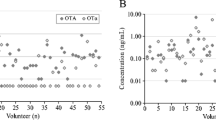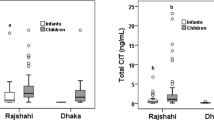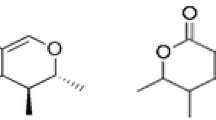Abstract
Biomonitoring studies can provide valuable insights into human mycotoxin exposure, especially when food contaminant data are scarce or unavailable as in Bangladesh. First biomonitoring data in Bangladeshi adults indicated exposure to the nephrotoxic mycotoxins ochratoxin A (OTA) and citrinin (CIT). This led us to conduct a follow-up study with analysis of urinary biomarkers for both CIT and OTA to investigate regional and seasonal influences on mycotoxin exposure in two Bangladeshi cohorts. In total, 164 urines were collected (n = 69 in summer, n = 95 in winter) from residents of a rural and an urban area, among which there were 62 participants enrolled in both sampling periods. Most urines had detectable biomarker levels (OTA, CIT and its metabolite dihydrocitrinone, HO-CIT), with more or less pronounced differences with regard to season and region. In both cohorts, OTA was found at a mean level of 0.06 ± 0.10 ng/mL urine (range 0.01–0.55 ng/mL) in summer and a mean of 0.19 ± 0.38 ng/mL (range 0.01–1.75 ng/mL) in winter season. A season difference was significant in the rural cohort, but not in the urban cohort, and slightly higher mean OTA levels in the rural compared to the urban cohort were only observed in winter urines. CIT biomarkers showed more pronounced variations, with a CIT mean of 0.10 ± 0.17 ng/mL (range 0.02–1.22 ng/mL) and HO-CIT mean of 0.42 ± 0.98 ng/mL (range 0.02–5.39 ng/mL) in summer, and CIT mean of 0.59 ± 0.98 ng/mL (range 0.05–5.03 ng/mL) and HO-CIT mean of 3.18 ± 8.49 ng/mL (range 0.02–46.44 ng/mL) in winter urines of both cohorts. In both seasons, total CIT biomarker concentrations were significantly higher in the rural cohort than in the urban cohort. A provisional daily intake for CIT was calculated and exceeded a preliminary value set by EFSA (0.2 µg/kg/d) in 10 and 24 % of participants in summer and winter, respectively. No significant correlations were found between urinary biomarker levels and intake of certain types of food, except for a positive trend for higher rice consumption. Our results in the Bangladeshi population indicate frequent co-exposure to nephrotoxic mycotoxin food contaminants that vary by season and region.



Similar content being viewed by others
Abbreviations
- CIT:
-
Citrinin
- HO-CIT:
-
Dihydrocitrinone
- OTA:
-
Ochratoxin A
- OTα:
-
Ochratoxin alpha
References
Ali N, Blaszkewicz M, Manirujjaman M, Perveen R, Nahid AA, Mahmood S, Rahman M, Hossain K, Degen GH (2014) Biomonitoring of ochratoxin A in blood plasma and exposure assessment of adult students in Bangladesh. Mol Nutr Food Res 58:2219–2225
Ali N, Blaszkewicz M, Degen GH (2015a) Occurrence of the mycotoxin citrinin and its metabolite dihydrocitrinone in urines of German adults. Arch Toxicol 89:573–578
Ali N, Blaszkewicz M, Mohanto NC, Rahman M, Alim A, Hossain K, Degen GH (2015b) First results on analysis of citrinin biomarkers in urines from two cohorts in Bangladesh. Mycotoxin Res 31:9–16
Ali N, Blaszkewicz M, Degen GH (2015c) Investigations on biomarkers of citrinin and ochratoxin A exposure in humans. 37th Mycotoxin workshop, June 1–3, 2015, Bratislava, Slovakia, Program and Abstract Book, Page 126 (# P66)
Bansal J, Pantazopoulos P, Tam J, Cavlovic P, Kwong K, Turcotte AM, Lau BP, Scott PM (2011) Surveys of rice sold in Canada for aflatoxins, ochratoxin A and fumonisins. Food Addit Contam Part A Chem Anal Control Expo Risk Assess 28:767–774
Blaszkewicz M, Liesenhoff-Henze K (2012) Creatinine in urine [Biomonitoring Methods, 2010]. The MAK Collection for Occupational Health and Safety, pp 169–184; Wiley VCH, Weinheim. doi:10.1002/3527600418.bi6027urie0012
Blaszkewicz M, Muñoz K, Degen GH (2013) Methods for analysis of citrinin in human blood and urine. Arch Toxicol 87:1087–1094
Castegnaro M, Maru V, Petkova-Bocharova T, Nikolov I, Bartsch H (1991) Concentrations of ochratoxin A in the urine of endemic nephropathy patients and controls in Bulgaria: lack of detection of 4-hydroxyochratoxin A. IARC Sci Publ 115:165–169
Castegnaro M, Canadas D, Vrabcheva T, Petkova-Bocharova T, Chernozemsky IN, Pfohl-Leszkowicz A (2006) Balkan endemic nephropathy: role of ochratoxin A through biomarkers. Mol Nutr Food Res 50:519–529
Coronel MB, Marin S, Tarragó M, Cano-Sancho G, Ramos AJ, Sanchis V (2011) Ochratoxin A and its metabolite ochratoxin alpha in urine and assessment of the exposure of inhabitants of Lleida, Spain. Food Chem Toxicol 49:1436–1442
Dawlatana M, Coker RD, Nagler MJ, Wild CP, Hassan MS, Blunden G (2002) The occurrence of mycotoxins in key commodities in Bangladesh: surveillance results from 1993 to 1995. J Nat Toxins 11:379–386
Dawlatana M, Shahida S, Rahim M, Hassan MT (2008) Investigation on the occurrence of ochratoxin A in maize in Bangladesh. Bangladesh J Sci Ind Res 43:495–500
Degen (2015) Are we ready to estimate daily ochratoxin A intake based on urinary concentrations? Environ Int (in press). doi:10.1016/j.envint.2015.10.010
Duarte SC, Bento JMV, Pena A, Lino CM (2009) Ochratoxin A exposure assessment of the inhabitants of Lisbon during winter 2007/2008 through bread and urine analysis. Food Addit Contam Part A Chem Anal Control Expo Risk Assess 26:1411–1420
Duarte S, Bento J, Pena A, Lino CM, Delerue-Matos C, Oliva-Teles T, Morais S, Correia M, Oliveira MBPP, Alves MR, Pereira JA (2010) Monitoring of ochratoxin A exposure of the Portuguese population through a nationwide urine survey—Winter 2007. Sci Total Environ 408:1195–1198
Duarte SC, Pena A, Lino CM (2011) Human ochratoxin A biomarkers: from exposure to effect. Crit Rev Toxicol 41:187–212
Duarte SC, Alves MR, Pena A, Lino CM (2012) Determinants of ochratoxin A exposure-A one year follow-up study of urine levels. Int J Hyg Environ Health 215:360–367
EC/SCOOP (2002) Assessment of dietary intake of ochratoxin A by the population of EU member states. Report of the Scientific Cooperation (SCOOP), task 3.2.7. Directorate General Health and Consumer Protection, European Commission. http://ec.europa.eu/food/fs/scoop/index_en.html
Ediage EN, Di Mavungu JD, Song S, Sioen I, De Saeger S (2013) Multimycotoxin analysis in urines to assess infant exposure: a case study in Cameroon. Environ Int 57–58:50–59
European Food Safety Authority (EFSA) (2006) Opinion of the Scientific Panel on Contaminants in the food chain on a request from the commission related to ochratoxin A in food. EFSA J 365:1–56. doi:10.2903/j.efsa.2006.365. http://www.efsa.europa.eu/en/efsajournal/pub/365
European Food Safety Authority (EFSA), Panel on Contaminants in the Food Chain (2012) Scientific Opinion on the risks for public and animal health related to the presence of citrinin in food and feed. EFSA J 10:2605. doi:10.2903/j.efsa.2012.2605. www.efsa.europa.eu/efsajournal
Ezekiel CN, Warth B, Ogara IM, Abia WA, Ezekiel VC, Atehnkeng J, Sulyok M, Turner PC, Tayo GO, Krska R, Bandyopadhyay R (2014) Mycotoxin exposure in rural residents in northern Nigeria: a pilot study using multi-urinary biomarkers. Environ Int 66:138–145
Föllmann W, Behm C, Degen GH (2014) Toxicity of citrinin and its metabolite dihydrocitrinone and of mixtures of citrinin and ochratoxin A in vitro. Arch Toxicol 88:1097–1107
Frisvad JC, Thrane U, Samson RA, Pitt JI (2006) Important mycotoxins and the fungi which produce them. Adv Exp Med Biol 571:3–31
Gambacorta S, Solfrizzo H, Visconti A, Powers S, Cossalter AM, Pinton P, Oswald IP (2013) Validation study on urinary biomarkers of exposure for aflatoxin B1, ochratoxin A, fumonisin B1, deoxynivalenol and zearalenone in piglets. World Mycotoxin J 3:299–308
Gerding J, Ali N, Schwartzbord J, Cramer B, Brown DL, Degen GH, Humpf HU (2015) A comparative study of the human urinary mycotoxin excretion patterns in Bangladesh, Germany and Haiti using a rapid and sensitive LC-MS/MS approach. Mycotoxin Res 31:127–136
Gilbert J, Brereton P, MacDonald S (2001) Assessment of dietary exposure to ochratoxin A in the UK using a duplicate diet approach and analysis of urine and plasma samples. Food Addit Contam 12:1088–1093
Heyndrickx E, Sioen I, Huybrechts B, Callebaut A, De Henauw S, De Saeger S (2015) Human biomonitoring of multiple mycotoxins in the Belgian population: results of the BIOMYCO study. Environ Int 84:82–89
Hornung RW, Reed LD (1990) Estimation of average concentration in the presence of nondetectable values. Appl Occup Environ Hyg 5:46–51
Huybrechts B, Debongnie Ph, Uhlig S, Callebaut A (2015) Fast and sensitive LC-MS/MS method measuring human mycotoxin exposure using biomarkers in urine. Arch Toxicol. doi:10.1007/s00204-014-1358-8
IARC (International Agency for Research on Cancer) (1993) Some naturally occurring substances: heterocyclic aromatic amines and mycotoxins. IARC Monogr Eval Carcinog Risk Chem Hum 56:397–444
IARC, International Agency for Research on Cancer (1986) Citrinin: some naturally occurring and synthetic food components, furocoumarins and ultraviolet radiation. IARC Monogr Eval Carcinog Risk Chem Hum 40:67
Islam GMR, Hoque MM (2013) Food safety regulation in Bangladesh, chemical hazard and some perception to overcome the dilemma. Intern Food Res J 20:47–58
Jeswal P, Kumar D (2015) Mycobiota and natural incidence of aflatoxins, ochratoxin A, and citrinin in Indian spices confirmed by LC-MS/MS. Int J Microbiol 2015:242486
Jonsyn FE (2000) Seasonal variation in exposure frequency and concentration levels of aflatoxins and ochratoxins in urine samples of boys and girls. Mycopathologia 152:35–40
Klapec T, Sarkanj B, Banjari I, Strelec I (2012) Urinary ochratoxin A and ochratoxin alpha in pregnant women. Food Chem Toxicol 50:4487–4492
Lai X, Liu R, Ruan C, Zhang H, Liu C (2015) Occurrence of aflatoxins and ochratoxin A in rice samples from six provinces in China. Food Control 50:401–404
Majeeda S, Iqbala M, Asib MR, Iqbalc SZ (2013) Aflatoxins and ochratoxin A contamination in rice, corn and corn products from Punjab, Pakistan. J Cereal Sci 58:446–450
Manique R, Pena A, Lino CM, Molto JC, Manes J (2008) Ochratoxin A in the morning and afternoon portions of urine from Coimbra and Valencian populations. Toxicon 51:1281–1287
Märtlbauer E, Usleber E, Dietrich R, Schneider E (2009) Ochratoxin A in human blood serum–retrospective long-term data. Mycotoxin Res 25:175–186
Meister U (2003) Detection of citrinin in ochratoxin A-containing products by a new HPLC method. Mycotoxin Res 19:27–30
Molinie A, Faucet V, Castegnaro M, Pfohl-Leszkowicz A (2005) Analysis of some breakfast cereals on the French market for their contents of ochratoxin A, citrinin and fumonisin B1: development of a method for simultaneous extraction of ochratoxin A and citrinin. Food Chem 92:391–400
Muñoz K, Blaszkewicz M, Degen GH (2010) Simultaneous analysis of ochratoxin A and its major metabolite ochratoxin alpha in plasma and urine for an advanced biomonitoring of the mycotoxin. J Chromatogr B 878:2623–2629
Muñoz K, Blaszkewicz M, Campos V, Vega M, Degen GH (2014) Exposure of infants to ochratoxin A with breast milk. Arch Toxicol 88:837–846
Nguyen M, Tozlovanu M, Tran T, Pfohl-Leszkowicz A (2007) Occurrence of aflatoxin B1, citrinin and ochratoxin A in rice in five provinces of the central region of Vietnam. Food Chem 105:42–47
Ostry V, Malir M, Ruprich J (2013) Producers and important dietary sources of ochratoxin A and citrinin. Toxins 5:1574–1586
Peraica M, Domijan A-M, Miletic-Medved M, Fuchs R (2008) The involvement of mycotoxins in the development of endemic nephropathy. Wien Klin Wochenschr 120:402–407
Petkova-Bocharova T, Castegnaro M, Michelon J, Maru V (1991) Ochratoxin A and other mycotoxins in cereals from an area of Balkan endemic nephropathy and urinary tract tumours in Bulgaria. IARC Sci Publ 115:83–87
Pfohl-Leszkowicz A (2009) Ochratoxin A and aristolochic acid in the nephropathies and associated urothelial tract tumours development. Arh Hig Rada Toksikol 60:465–483
Reddy BN, Nusrath M, Kumari CK, Nahdi S (1983) Mycotoxin contamination in some food commodities from tribal areas of Medak District, Andhra Pradesh. Indian Phytopathol 36:683–686
Saxena J, Mehrotra BS (1989) Screening of spices commonly marketed in India for natural occurrence of mycotoxins. J Food Compos Anal 2:286–292
Schmidt S, Brockmeyer A, Knor K, Thielert G (2003) Vorkommen von Citrinin in Getreide. Mycotoxin Res 19:129–133
Schmidt-Heydt M, Stoll D, Schütz P, Geisen R (2015) Oxidative stress induces the biosynthesis of citrinin by Penicillium verrucosum at the expense of ochratoxin. Int J Food Microbiol 192:1–6
Solfrizzo M, Gambacorta L, Visconti A (2014) Assessment of multi-mycotoxin exposure in southern italy by urinary multi-biomarker determination. Toxins 6:523–538
Stoll D, Schmidt-Heydt M, Geisen R (2013) Differences in the regulation of ochratoxin A by the HOG pathway in Penicillium and Aspergillus in response to high osmolar environments. Toxins (Basel) 5:1282–1298
Studer-Rohr I, Schlatter J, Dietrich DR (2000) Kinetic parameters and intraindividual fluctuations of ochratoxin A plasma levels in humans. Arch Toxicol 74:499–510
Turner PC, Flannery B, Isitt C, Ali M, Pestka J (2012) The role of biomarkers in evaluating human health concerns from fungal contaminants in food. Nutr Res Rev 25:162–179
Vrabcheva T, Usleber EI, Dietrich R, Märtlbauer E (2000a) Co-occurrence of ochratoxin A and citrinin in cereals from Bulgarian villages with a history of Balkan endemic nephropathy. J Agric Food Chem 48:2483–2488
Vrabcheva T, Usleber E, Petkova-Bocharova T, Nikolov I, Chernozemsky I, Dietrich R, Märtlbauer E (2000b) Citrinin in the diet of young and healthy persons living in Balkan endemic nephropathy areas. Mycotoxin Res 16(Suppl. 2):150–153
Wallin S, Gambacorta L, Kotova N, Warensjö Lemming E, Nälsén C, Solfrizzo M, Olsen M (2015) Biomonitoring of concurrent mycotoxin exposure among adults in Sweden through urinary multi-biomarker analysis. Food Chem Toxicol 83:133–139
Yogendrarajah P, Jacxsens L, De Saeger S (2014) Co-occurrence of multiple mycotoxins in dry chilli (Capsicum annum L.) samples from the markets of Sri Lanka and Belgium. Food Control 46:26–34
Acknowledgments
The authors wish to thank I. Glaeser, G. Baumhoer, M. Porta and B. Aust for excellent technical assistance and all the study participants. This work was supported by a DAAD scholarship to Nurshad Ali and a grant from the Brigitte und Wolfram Gedek-Stiftung to Gisela H. Degen.
Author information
Authors and Affiliations
Corresponding author
Ethics declarations
Conflict of interest
None of the authors have any conflict of interest to declare.
Electronic supplementary material
Below is the link to the electronic supplementary material.
Rights and permissions
About this article
Cite this article
Ali, N., Blaszkewicz, M., Alim, A. et al. Urinary biomarkers of ochratoxin A and citrinin exposure in two Bangladeshi cohorts: follow-up study on regional and seasonal influences. Arch Toxicol 90, 2683–2697 (2016). https://doi.org/10.1007/s00204-015-1654-y
Received:
Accepted:
Published:
Issue Date:
DOI: https://doi.org/10.1007/s00204-015-1654-y




